In the future, the further I must place the light away from the subject, the closer to loop lighting I will use. The closer I can place the light, the closer to rembrandt lighting I will use. As a general rule of course. Harder shadow edges seem to work better with loop pattern, and softer shadow edges work better with rembrandt. This is because rembrand pattern allows for a lot of islands of light that look too much like cutouts when they are hard edged. These shapes smooth out and soften with the same light mod moved closer (so as to appear larger to the subject). Loop pattern more evenly illuminates the front mask of the face, so you can get away with slightly harder shadows.
Also, I think it's just good to know your gear inside and out. So you can operate it transparently, spending all your time on taking photos, rather than fiddling with knobs and menus, and also so that you don't lose out on a good shot, for lack of familiarity. At this point I know my lenses, and the camera quite well, but since this is a new light modifier system, I am still learning it. I decided a series of scientific tests were in order.
First, the gear itself (this is also a mini-review):
This is the Chimera XXS (extra extra small) with silver lining. It's 30x40cm (12x16in) It has two baffles, inner and outter. It's super well made, easy to setup, and the rods are nice and sturdy, while being very springy and easy to insert.
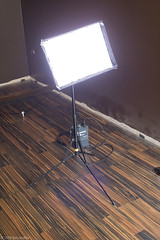
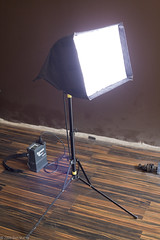
This is the 20 degree fabric grid for the above softbox. It's expensive, but it's really well made, and it changes the light in a way you can't really get otherwise. It velcros into the front of the softbox, leaving no gaps, which is very nice. It collapses very small, and comes with a small velcro strip that holds it shut. It also comes with a small drawstring bag.
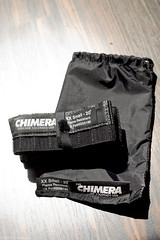
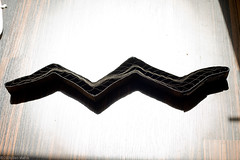

Here is the grid attached to the flash. notice how it blocks the light from the side.
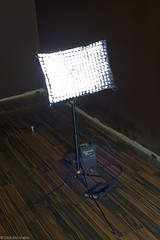
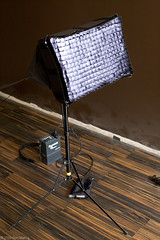
At 2 meters, the grid restricts the beam to a 1.2 meter circle. At 3 meters, the beam is closer to 1.8 meters in size. It gives me a nice tight beam to put only on a person's face, which is how I prefer to light my environmental portraits.
For the test, my setup was:
- Matt on the ground to make sure subject is always in the same location.
- Camera on a tripod to ensure camera to subject distance stays the same.
- Measuring tape stretched from matt at 45 degree angle, to allow measurement of the light distance.
- Light moved from 1 meter, then 2 meters, then 3 meters from subject. Flash output adjusted to maintain proper exposure.
- One round with bare softbox, one round with 20 degree grid installed.
- Crop and process in Lightroom so exposure is the same for all, and in B&W so that the shadow edge and specular could really be visible.
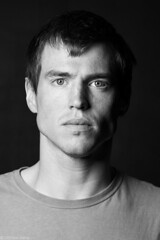
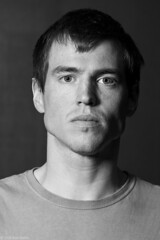
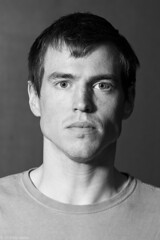
In this row, you see the softbox with the 20 degree grid. First is 1 meter, last is 3 meters distance.



They really have to be examined both at this small size, as well as in large full size to appreciate the differences. It might appear to be pixel peeping, but when comparing the 1 meter, directly to the 3 meter, there is a definite softness to the 1 meter that the 3 meter lacks. At 1 meter away, the corner of the face that is closest to the light, is brighter than the corner farther away. Once moved to 3 meters, this distance is too small for that affect, so the 3 meter version is very flat. The specular is more pronounced, and the shadow edges are harder.
I definitely prefer the 1 meter version, and with the grid it has slightly more volume, while maintaining almost the same level of softness. However I can't always keep the light just 1 meter away. The 3 meter is not what I want. Too hard edged of shadows, specular hotspots too hot, and the transition from diffused highlight to shadow, is too harsh. It really emphasizes the skin texture, in a way I don't like. The 2 meter is an ok compromise, but still a bit too much.
I'm glad to have done this test, as I now know my "hard limit" for how far away I place this light mod. I will keep it within 1 meter whenever possible, and keep a 2 meter distance as my maximum. The last shoot had the light more like 3.5 meters away, and unnecessarily so. I could have easily brought it to about 1.5 meters, and had I already done this test and known this behavior of the light, I would have.


I have been reading your blog for a while now, trying to figure out how strobist works. I think you're beyond my comprehension, and it doesn't help that I can't practice because I don't have any flashes or stands or umbrellas. I'd like to start simpler though, what lens do you use for portraits?
ReplyDeleteI have 3 lenses, 35mm, 50mm, and 85mm, and I switch based on how wide or compressed I want the background to be. My general rule of thumb, is if I've got the entire person in the frame, I use the 35mm. If I have only the waist up, or I want a full body that has a compressed background, I use the 50mm, and if I'm doing a face study or headshot, or want an *extremely* compressed background, I use the 85mm. I need to do a post about lens field of view, so thanks for asking, it's prompted me to do this.
ReplyDeleteI'm photographing food, and my questions relate to that, though they could be important for any small product shot.
ReplyDeleteDoes the grid focus the light, or is it more a spill control device?
Does a gridded softbox light both near and far objects more evenly?
It does light near and far more evenly, by how much, I couldn't tell you. But the tighter the grid, the less the falloff.
ReplyDeleteNice article. The shadows in your test shots without the grid have a more washed out look to them. I see what you mean by the shadows being a bid to hard at 3 meters especially on the nose.
ReplyDelete